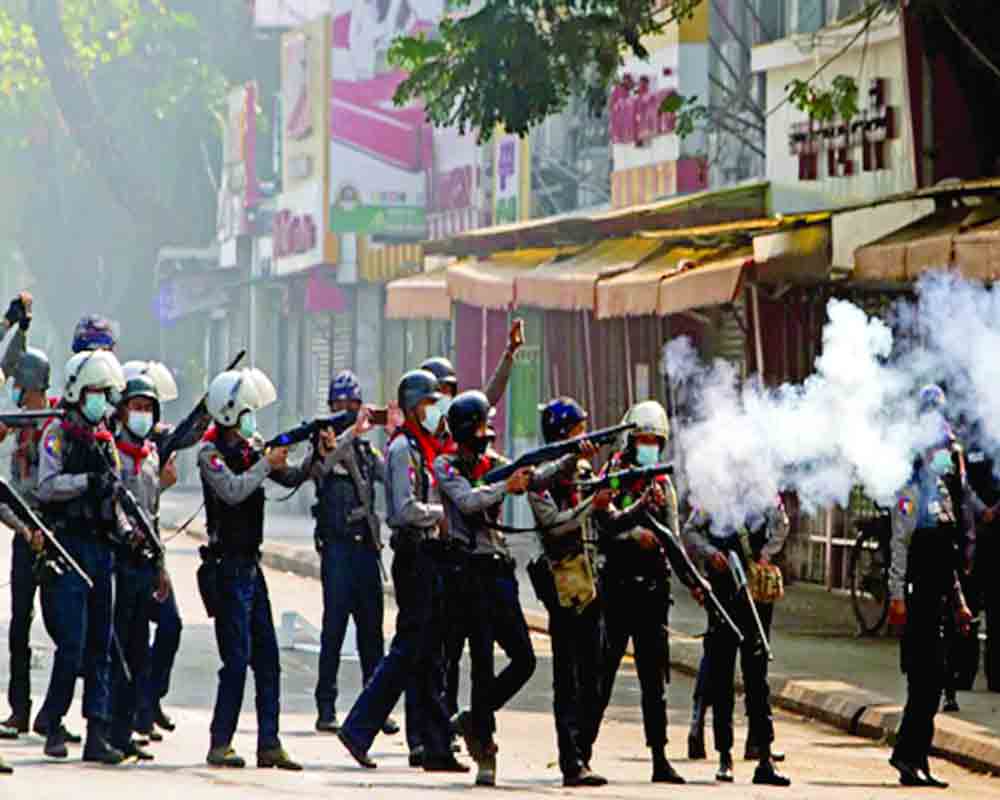The Junta feels emboldened as the world’s gaze shifts to Gaza; it continues with its savage war against its own people and persecuting its political opponents
Events in Myanmar have gone under the radar of global discourse with the latter’s attention focused on the developments in West Asia—Hamas’ terrorist attack on Israel and the latter’s gruesome retaliatory strikes on civilians in Gaza—and the war in Ukraine. This is unfortunate. With the pressure of global disapprobation weakening with the shifting focus, the ruling junta continues with its savage war against its own people, persecuting its political opponents, and unleashing horrendous violence.
According to a report datelined May 11, 2023, in the website The Irrawaddy, the Junta continues to crush all political opposition, having dissolved at least 40 political parties including the National League for Democracy (NLD), led by Daw Aung San Suu Kyi. Members of the NLD, their families and supporters have been regularly attacked and killed since the coup on February 1, 2021, which prevented the NLD, which had swept the elections to the national parliament held on November 8, 2020, from forming government. At least 1,235 NLD members have been detained, 26 have died during interrogation or in detention, and 63 others have been killed unlawfully, according to a statement released by the NLD on March 29. Not just this. The United Nations High Commissioner of Human Rights reported, on June 28, 2023, that at least 3,452 people had been killed by the military and its allies since the coup.
According to the United National High Commissioner for Refugees’ Operational Data Portal, the total number of internally displaced persons was 1,975,000 as last updated on October 9, 2023. The figure includes people fleeing the junta’s attacks on villages and towns, air strike and persecution, those with arrest warrants in their names, young protestors and their parents hounded by the police, civilians providing financial support to the NUG, and civil servants involved in the civil disobedience movement and so on.
Understandably, repression of this magnitude and savagery has spawned armed resistance. Some leaders of the NUG, activists and representatives of several insurgent ethnic organisations and minor parties, formed a National Unity Government (NUG) on April 16, 2021. In May 2021, NUG announced the formation of its armed wing, the People's Defence Force (PDF). In an article in The Irrawaddy datelined November 24, 2022, Banyar Aung put the PDF’s strength at 65,000.
It has been attacking the Sit-Tat with increasing frequency and success. According to a report in The Irrawaddy, datelined October 18, 2023, it killed at least 28 Junta troops in incidents reported from Sagaing, Magwe, Mandalay, Bago and Tanintharyi regions in four preceding days. The Sit-Tat is also worried by drone strikes by the resistance forces. One of these, targeting the Myawaddy District Administration Department office in Karen State’s Myawaddy Town killed five junta officials, including a district administrator and military battalion commander. Eleven policemen, including a superintendent, were injured.
Not surprisingly, a brief released on September 5, 2022, by the Special Advisory Council for Myanmar, a group of international experts supporting the country’s struggle for democracy, said that the junta had stable control over only 72 out of the country’s 330 townships, constituting only 17 per cent of Myanmar’s land area.”. The NUG and ethnic resistance organisations effectively controlled over 52 per cent of Myanmar’s territory and 23 per cent was contested.
Driven on the backfoot on the ground, the junta has increasingly resorted to air-strikes. Haley Willis and Weiyi Cai stated in a report in The New York Times of July 31, 2023, that there were nearly twice as many military airstrikes reported in April, May and June as in the first three months of the year. The maximum number of strikes in any month this year, 40, were in June. The average of 30 airstrikes per month up to now this year, has been the highest for any year of the conflict so far. The report quotes Anthony Davis, an analyst for the Janes group of military publications and an expert on the Myanmar military, as saying, that the military’s strategy was to punish the civilian population for any perceived support to the opposition.
A special target has been the Sagaing Region in north-western part Myanmar, bordering India. It is a rebel stronghold where the military’s ground forces have had difficulty gaining territory. The worst airstrike since the coup on February 1, 2021, occurred in Pazigyi Village in the southern part of the region on April 11, 2023. The target of bombing and strafing by military jets and helicopters, was a gathering to celebrate the local resistance movements opening of an administrative office there. At least 170 persons, most of them civilians and at least 30 of them children, were killed.
The military hardware for such attacks by the Sit-Tat, including military aircraft, comes from China, Russia and even some south-east Asian countries. Russia, according to its state news agency RIA, signed a contract in September, 2022, for the delivery of six Su-30SME fighter jets, to Myanmar. Two of these arrived last month. Since Russia and China are unlikely to stop delivering combat supplies, the only way to stop the aerial attacks is to deny aviation fuel supplies to Myanmar. Unfortunately, Western countries swearing by democracy, are hardly doing anything effective to stanch the flow.
(The author is Consulting Editor, The Pioneer. The views expressed are personal)


























